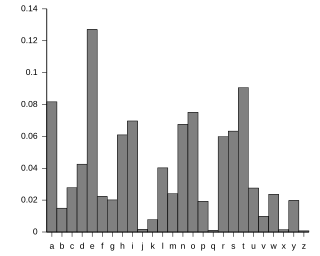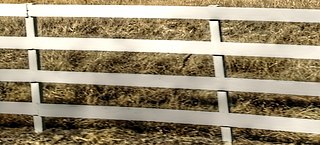In cryptography, a substitution cipher is a method of encrypting in which units of plaintext are replaced with the ciphertext, in a defined manner, with the help of a key; the "units" may be single letters, pairs of letters, triplets of letters, mixtures of the above, and so forth. The receiver deciphers the text by performing the inverse substitution process to extract the original message.

In cryptography, a transposition cipher is a method of encryption which scrambles the positions of characters (transposition) without changing the characters themselves. Transposition ciphers reorder units of plaintext according to a regular system to produce a ciphertext which is a permutation of the plaintext. They differ from substitution ciphers, which do not change the position of units of plaintext but instead change the units themselves. Despite the difference between transposition and substitution operations, they are often combined, as in historical ciphers like the ADFGVX cipher or complex high-quality encryption methods like the modern Advanced Encryption Standard (AES).

The Vigenère cipher is a method of encrypting alphabetic text where each letter of the plaintext is encoded with a different Caesar cipher, whose increment is determined by the corresponding letter of another text, the key.

In cryptography, the tabula recta is a square table of alphabets, each row of which is made by shifting the previous one to the left. The term was invented by the German author and monk Johannes Trithemius in 1508, and used in his Trithemius cipher.

In cryptanalysis, frequency analysis is the study of the frequency of letters or groups of letters in a ciphertext. The method is used as an aid to breaking classical ciphers.

The Playfair cipher or Playfair square or Wheatstone–Playfair cipher is a manual symmetric encryption technique and was the first literal digram substitution cipher. The scheme was invented in 1854 by Charles Wheatstone, but bears the name of Lord Playfair for promoting its use.
Some Buddhist terms and concepts lack direct translations into English that cover the breadth of the original term. Below are given a number of important Buddhist terms, short definitions, and the languages in which they appear. In this list, an attempt has been made to organize terms by their original form and give translations and synonyms in other languages along with the definition.
In cryptography, the ADFGVX cipher was a manually applied field cipher used by the Imperial German Army during World War I. It was used to transmit messages secretly using wireless telegraphy. ADFGVX was in fact an extension of an earlier cipher called ADFGX which was first used on 1 March 1918 on the German Western Front. ADFGVX was applied from 1 June 1918 on both the Western Front and Eastern Front.
In classical cryptography, the bifid cipher is a cipher which combines the Polybius square with transposition, and uses fractionation to achieve diffusion. It was invented around 1901 by Felix Delastelle.
"The Alphabet Cipher" was a brief study published by Lewis Carroll in 1868, describing how to use the alphabet to send encrypted codes. It was one of four ciphers he invented between 1858 and 1868, and one of two polyalphabetic ciphers he devised during that period and used to write letters to his friends.
In cryptography, a classical cipher is a type of cipher that was used historically but for the most part, has fallen into disuse. In contrast to modern cryptographic algorithms, most classical ciphers can be practically computed and solved by hand. However, they are also usually very simple to break with modern technology. The term includes the simple systems used since Greek and Roman times, the elaborate Renaissance ciphers, World War II cryptography such as the Enigma machine and beyond.
Probabilistic encryption is the use of randomness in an encryption algorithm, so that when encrypting the same message several times it will, in general, yield different ciphertexts. The term "probabilistic encryption" is typically used in reference to public key encryption algorithms; however various symmetric key encryption algorithms achieve a similar property, and stream ciphers such as Freestyle which are inherently random. To be semantically secure, that is, to hide even partial information about the plaintext, an encryption algorithm must be probabilistic.

In classical cryptography, the Hill cipher is a polygraphic substitution cipher based on linear algebra. Invented by Lester S. Hill in 1929, it was the first polygraphic cipher in which it was practical to operate on more than three symbols at once.

The rail fence cipher is a classical type of transposition cipher. It derives its name from the manner in which encryption is performed, in analogy to a fence built with horizontal rails.

Editions of the word board game Scrabble in different languages have differing letter distributions of the tiles, because the frequency of each letter of the alphabet is different for every language. As a general rule, the rarer the letter, the more points it is worth.
The Two-square cipher, also called double Playfair, is a manual symmetric encryption technique. It was developed to ease the cumbersome nature of the large encryption/decryption matrix used in the four-square cipher while still being slightly stronger than the single-square Playfair cipher.
In cryptography, an interpolation attack is a type of cryptanalytic attack against block ciphers.
The Smithy code is a series of letters embedded, as a private amusement, within the April 2006 approved judgement of Mr Justice Peter Smith on The Da Vinci Code copyright case. The judge publicly admitted that "I can't discuss the judgement, but I don't see why a judgement should not be a matter of fun." It was first broken, in the same month, by Dan Tench, a lawyer who writes on media issues for The Guardian, after he received a series of email clues about it from Justice Smith.
ACE is the collection of units, implementing both a public key encryption scheme and a digital signature scheme. Corresponding names for these schemes — «ACE Encrypt» and «ACE Sign». Schemes are based on Cramer-Shoup public key encryption scheme and Cramer-Shoup signature scheme. Introduced variants of these schemes are intended to achieve a good balance between performance and security of the whole encryption system.







